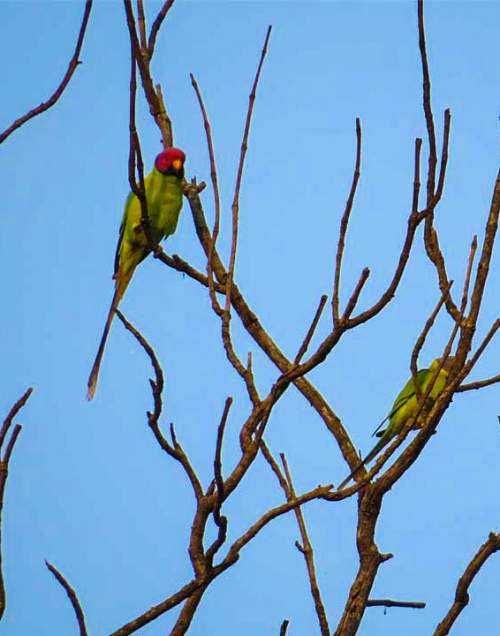The blossom-headed parakeet (Psittacula roseata) belongs to the family of parakeets, Psittaculidae.
These species of parakeet are distributed in India, Nepal, Bhutan, Bangladesh, China, Myanmar, Thailand, Cambodia, Laos and vietnam. The blossom-headed parakeets are resident birds in their range. There are two recognized subspecies of these parakeets.
Blossom-headed parakeet - Overview
- Scientific name: Psittacula roseata
- Species author: Biswas, 1951
- Synonyms/Protonym: Psittacula roseata Biswas, 1951
- Family: Psittaculidae › Psittaciformes › Aves › Chordata › Animalia
- Vernacular names: English: Blossom-headed parakeet, Chinese: 花头鹦鹉, French: Perruche à tête rose, German: Rosenkopfsittich, Spanish: Cotorra carirrosa, Russian: Розовоголовый кольчатый попугай, Japanese: バライロコセイインコ, Malay: Burung Bayan Bali
- Other names: Eastern Blossom-headed Parakeet, Rosy-headed Parakeet
- Distribution: India, Nepal, Bhutan, Bangladesh, China, Myanmar, Thailand, Cambodia, Laos, vietnam
- Diet and feeding habits: seeds, grain, shoots, blossom, leaves, buds, berries, nuts
- IUCN status listing: Near Threatened (NT)
Appearance, physical description and identification
The blossom-headed parakeet (Psittacula roseata) is a green parakeet, measuring 30 to 35 cm in length.These parakeets appear very similar to plum-headed parakeet (Psittacula cyanocephala). These species are sexually dimorphic. The male bird has a pink head, turning pale bluish lilac on the back of the crown, nape and cheeks. There is a narrow black collar band and a black patch on the chin. The back and rump are green. The breast and underside are yellowish green.
The female has pale bluish gray head. It lacks the collar band and the chin patch. The upper mandible is highly curved and is yellow. The lower mandible is blackish in males whereas in females both the mandibles are pale yellow. The male has a maroon shoulder patch, which is lacking in female.
The distinguishing characteristics between plum-headed parakeet and blossom-headed parakeet are: the former has red head, red shoulder patch, long tail with white tip whereas the later has pink head, maroon shoulder patch, shorter tail with yellowish tip. The blossom-headed parakeet call is a very loud, shrill screeching sound.
 |
| Indian birds - Picture of Blossom-headed parakeet - Psittacula roseata by Abbas Hasnain |
 |
| Birds of India - Image of Blossom-headed parakeet - Psittacula roseata by Nazmul Shanji |
Origin, geographical range and distribution
The blossom-headed parakeet is distributed in India, Nepal, Bhutan, Bangladesh, China, Myanmar, Thailand, Cambodia, Laos, vietnam. In northeastern India these parakeet species are distributed in the states of Bihar, West Bengal, Assam, Meghalaya, Arunachal Pradesh, Nagaland, Manipur and Tripura.The blossom-headed parakeet subspecies P. r. roseata is distributed in Nepal, Bhutan, India, Bangladesh and Myanmar. The subspecies P. r. juneae is distributed in Myanmar, Thailand, Cambodia, Laos, Vietnam and South China.
The Important Bird and Biodiversity Areas (IBA) of the blossom-headed parakeet species in Cambodia are Upper Srepok Catchment and Kirirom. The IBAs in Laos are Attapu Plain, Dong Kalo, Dong Khanthung and Xe Kong Plains. The IBAs in Nepal are Chitwan National Park, Koshi Tappu Wildlife Reserve and Koshi Barrage.
Ecosystem and habitat
These blossom-headed parakeet species are moderately forest dependent. They inhabit various open woodland ecosystems. They inhabit farmlands, fallow agricultural fields, parks, rural gardens, plantations, degraded forests, subtropical forests, tropical moist lowlands, deciduous woods, dry tropical shrubland, temperate shrubland and the edges of cultivated clearings. They occur in altitudes of 0 to 1500 meters.Diet and feeding behavior
The diet of these blossom-headed parakeet species is mostly fruits, nuts, berries, leaves, buds, blossom, seeds, shoots and grain. They are mostly arboreal usually feed on the trees.Reproduction and breeding habits
The breeding season of these blossom-headed parakeet species is from February to April in Myanmar whereas the breeding season is from March to May in Thailand. They nest in tree cavities and abandoned tree-holes of the woodpeckers. Normally the clutch has 4 to 5 eggs.Migration and movement patterns
These blossom-headed parakeet species are sedentary and resident birds. Post breeding dispersal of juveniles takes place. They may make local movements for feeding and breeding.Conservation status and concerns
The global population size of the blossom-headed parakeet (Psittacula roseata) is not quantified. The overall population size of these species is considered to be decreasing. In several ranges where it was earlier considered to be common or abundant, the parakeet has become uncommon and rare.The degradation of the habitat and trapping for pet trade are the main threats to the survival of these parakeet species. Their generation length is 7.5 years. The blossom-headed parakeet is fast approaching the thresholds for being Vulnerable under the range size criterion, under the population trend criterion and also under the population size criterion.
The Convention on International Trade in Endangered Species of Wild Fauna and Flora (CITES) has listed these parakeet in the Appendix II. The IUCN (International Union for Conservation of Nature) has categorized and evaluated the The blossom-headed parakeet (Psittacula roseata) and has listed it as "Near Threatened".
1.Image source: https://commons.wikimedia.org/wiki/File:Blossom-headed_Parakeet_Psittacula_roseata_both_sex_male_and_female_together.jpg
Image author: Abbas Hasnain | License: CC BY-SA 3.0
2.Image source: https://www.flickr.com/photos/unsocial/21400554974/
Image author: Nazmul Shanji | License: CC BY-NC-ND 2.0 (as on 2016-12-16)
Current topic in Birds of India: Blossom-headed parakeet - Psittacula roseata.
